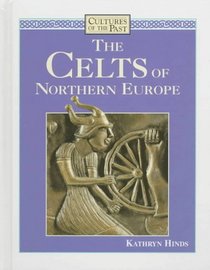This is a book for younger readers (ages 9 12) but the subject has intrigued me for some time. Ive always wanted to know where the Celts came from in their quest to overtake Europe and Asia Minor.
T he photographs of artifacts are quite exceptional and are clearly explained. I would have appreciated the map of Celtic conquests to have appeared earlier in the book. The time line for the Ancient Celts (both BCE {Before the Common Era} and CE {during the Common Era}) helped keep things straight. Theres also a glossary that explains complex words and concepts that were used in the book.
The side bar topics add a great deal to the subject covered; i.e. sacred animals, chariot warfare and the four festivals important to the Celts.
Kathryn Hinds certainly knows Celtic art and culture. The book has five main chapters:
1) THE CELT TRIBES ON THE MOVE: They began in Hallstatt (in Austria) and moved both east and west. The Celts were a long-term pain to the Romans while the Greeks handled them much more effectively.
2) THE CELTIC ART OF LIVING: How the Celts lived, their art and the learning they valued. The photo of a home interior [a reconstruction] proves the adage that a picture is worth a thousand words. Because they did not have a written language, we do not know much about the early Celtic communities.
3) DEITIES IN THEIR MIDST: This section takes a look at the deities that were important to the Celts.
4) THE CELTIC IDEAL IN PRACTICE: It took druids 20 years to become a fully-fledged druid; they really were more powerful than the king. They could stop a battle just by stepping between 2 forces on the battlefield.
5) A LIVING CULTURE: This section traces the oral tradition of the Celts, their assimilation (most groups) and their rise again when a portion of Ireland became independent.
T he photographs of artifacts are quite exceptional and are clearly explained. I would have appreciated the map of Celtic conquests to have appeared earlier in the book. The time line for the Ancient Celts (both BCE {Before the Common Era} and CE {during the Common Era}) helped keep things straight. Theres also a glossary that explains complex words and concepts that were used in the book.
The side bar topics add a great deal to the subject covered; i.e. sacred animals, chariot warfare and the four festivals important to the Celts.
Kathryn Hinds certainly knows Celtic art and culture. The book has five main chapters:
1) THE CELT TRIBES ON THE MOVE: They began in Hallstatt (in Austria) and moved both east and west. The Celts were a long-term pain to the Romans while the Greeks handled them much more effectively.
2) THE CELTIC ART OF LIVING: How the Celts lived, their art and the learning they valued. The photo of a home interior [a reconstruction] proves the adage that a picture is worth a thousand words. Because they did not have a written language, we do not know much about the early Celtic communities.
3) DEITIES IN THEIR MIDST: This section takes a look at the deities that were important to the Celts.
4) THE CELTIC IDEAL IN PRACTICE: It took druids 20 years to become a fully-fledged druid; they really were more powerful than the king. They could stop a battle just by stepping between 2 forces on the battlefield.
5) A LIVING CULTURE: This section traces the oral tradition of the Celts, their assimilation (most groups) and their rise again when a portion of Ireland became independent.




